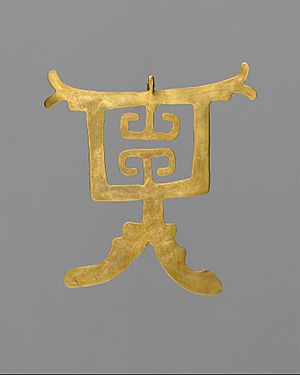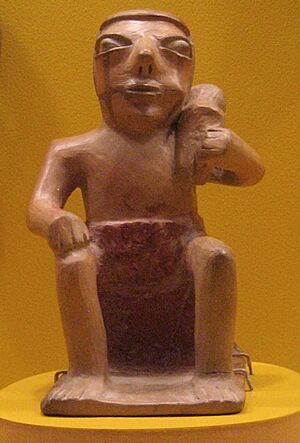Capulí culture facts for kids
The Capulí culture was an ancient group of people. They lived in South America, in what is now northern Ecuador and southern Colombia. They lived on the high plains of the Andes mountains. The Capulí people lived from about 800 AD to 1500 AD. They came before the Piartal and Tuza cultures in this area. We know a lot about the Capulí culture from their amazing pottery.
Contents
Discovering the Capulí Culture
The Capulí people left behind many clues about their lives. These clues help us understand their history. Archaeologists study these clues to learn about ancient groups. The Capulí culture is known for its unique art and burial customs.
What Was Capulí Pottery Like?
The Capulí culture made very special pottery. It often had black designs on a dark red background. These designs were usually straight lines and geometric shapes. They also made striking statues out of clay. These statues often looked like people.
The "Coquero" Figures
Many Capulí statues show people with something in their mouths. These figures are often called coqueros. This name comes from the coca plant. The statues show people chewing leaves from this plant. Women in these statues wear long wraps from their armpits to their ankles. Men often wear loincloths. They are sometimes shown holding things like drums or animals. These figures might represent important people or special ceremonies.
How Did the Capulí Work with Gold?
The Capulí people were also skilled gold workers. They created beautiful objects from high-quality gold. They would hammer and solder the gold. This means they shaped it and joined pieces together. Their gold designs included geometric shapes and animal figures. Some of the most unique ancient gold art from this region comes from the Capulí time.
What Were Capulí Graves Like?
The Capulí people buried their dead in special ways. Their graves often contained interesting items. These items included conch shells and stone axes. Some graves found in Nariño, Colombia, were very deep. Some went as deep as 40 meters (about 130 feet)!
Graves in Carchi, Ecuador, were also deep at first. They could be over 10 meters (about 33 feet) deep. Later, these graves were only about 2 meters (about 6.5 feet) deep. The graves were usually oval-shaped, wider than they were deep. It seems the burial chambers were kept open. The tunnels leading to them were filled in after the burial.



